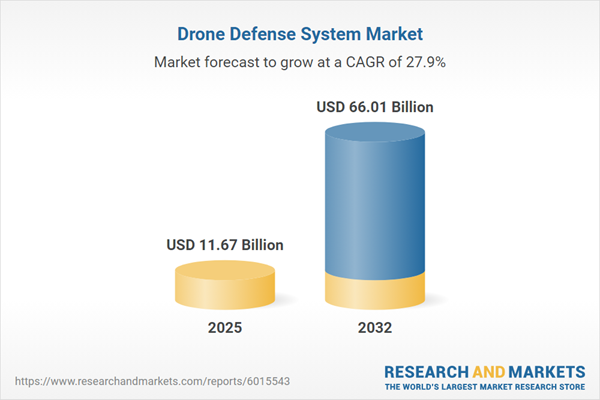Speak directly to the analyst to clarify any post sales queries you may have.
The Drone Defense System Market continues to evolve rapidly, propelled by innovative technologies and complex global security requirements. Advanced drone defense solutions are now essential for safeguarding airspace integrity and ensuring operational security across both civilian and military domains.
Market Snapshot: Drone Defense System Market Growth
The Drone Defense System Market grew from USD 9.24 billion in 2024 to USD 11.67 billion in 2025. Sustained innovation and rising adoption are expected to drive a CAGR of 27.85%, bringing the market to USD 66.01 billion by 2032. This growth reflects the escalating need for airspace security solutions and the increasingly dynamic regulatory and threat environment. The primary keyword, Drone Defense System Market, remains at the core of airspace security advancements for senior decision-makers evaluating risk management solutions.
Scope & Segmentation of the Drone Defense System Market
- System Type: Anti-Drone Systems, Counter-Measure Systems, Detection Systems
- Component: Hardware (Actuators, Controllers, Jammers, Lasers, Radars, Sensors), Services (Installation, Maintenance & Support Services), Software (Detection Software, Tracking Algorithms)
- Deployment: Ground-Based Systems, Handheld Systems, UAV-Based Systems
- Range: Less Than 5 km, More Than 5 km
- Application: Alerting, Classification & Detection, Locating & Tracking
- End-Users: Civil Aviation Authorities, Commercial (Critical Infrastructure, Public Venues), Military & Homeland Security, Private Security Corporations
- Region: Americas (United States, Canada, Mexico, Brazil, Argentina, Chile, Colombia, Peru), Europe, Middle East, and Africa (United Kingdom, Germany, France, Russia, Italy, Spain, Netherlands, Sweden, Poland, Switzerland, United Arab Emirates, Saudi Arabia, Qatar, Turkey, Israel, South Africa, Nigeria, Egypt, Kenya), Asia-Pacific (China, India, Japan, Australia, South Korea, Indonesia, Thailand, Malaysia, Singapore, Taiwan)
- Companies Analyzed: Adani Group, Advanced Protection Systems S.A., Airbus SE, Allen-Vanguard Corporation, Anduril Industries, BAE Systems PLC, Bharat Electronics Ltd., D-Fend Solutions AD Ltd., Dedrone Holdings, DeTect Inc, DroneShield Ltd., DZYNE Technologies, Elbit Systems, Fortem Technologies, Honeywell International, Israel Aerospace Industries, L3Harris Technologies, Leonardo S.p.A., Lockheed Martin, Northrop Grumman, Rafael Advanced Defense Systems, Rheinmetall AG, RTX Corporation, Saab AB, Singapore Technologies Engineering, SkySafe Inc., Teledyne FLIR, Thales Group, The Boeing Company, Toshiba Corporation, Zen Technologies Limited
Key Takeaways for Decision-Makers
- The integration of artificial intelligence, sensor fusion, and directed energy is transforming detection, classification, and neutralization processes.
- Regulatory evolution is creating clear technical benchmarks, accelerating adoption, and promoting interoperability across governmental and commercial sectors.
- Strategic partnerships among vendors, regulatory bodies, and end users are enabling more robust and responsive defense ecosystems.
- The use of AI-driven analytics is expanding, allowing for predictive threat assessment and faster mitigation protocols.
- Regional expansion is influenced by local regulatory mandates, defense budgets, and increasingly sophisticated threat actors targeting infrastructure and public spaces.
- The competitive landscape is characterized by modular offerings, open standards, and the emergence of specialized, regionally tailored solutions.
Tariff Impact: Navigating U.S. Trade Policy Shifts
The 2025 United States tariff adjustments have affected supply chain strategies and cost structures for system developers. Increased duties on critical hardware components originating from global manufacturers have prompted renewed focus on supplier diversification, local manufacturing initiatives, and long-term procurement contracts. Tariff-driven changes are also accelerating demand for domestically developed software and alternative mitigation solutions with locally sourced materials.
Methodology & Data Sources
This report is grounded in primary interviews with senior decision-makers, technology integrators, and end users across multiple geographies. Methodologies include trend mapping, SWOT analysis, and competitive benchmarking. Triangulation with secondary sources and iterative validation with industry stakeholders ensure actionable, up-to-date intelligence for the Drone Defense System Market.
Why This Report Matters
- Offers a comprehensive view of technology, regulation, and market segmentation—empowering leaders to plan resilient airspace security strategies.
- Enables clear assessment of competitive dynamics, supplier options, and emerging partnership opportunities across all geographies.
- Supports senior decision-makers in identifying where innovation, regulation, and new investment will exert the greatest market impact.
Conclusion
The Drone Defense System Market is evolving in response to complex global risks, regulatory mandates, and technological innovation. Forward-looking strategies and collaborative ventures are critical for organizations securing operational advantages and resilience against evolving threats.
Additional Product Information:
- Purchase of this report includes 1 year online access with quarterly updates.
- This report can be updated on request. Please contact our Customer Experience team using the Ask a Question widget on our website.
Table of Contents
3. Executive Summary
4. Market Overview
7. Cumulative Impact of Artificial Intelligence 2025
Companies Mentioned
The companies profiled in this Drone Defense System market report include:- Adani Group
- Advanced Protection Systems S.A.
- Airbus SE
- Allen-Vanguard Corporation
- Anduril Industries, Inc.
- BAE Systems PLC
- Bharat Electronics Ltd.
- D-Fend Solutions AD Ltd.
- Dedrone Holdings, Inc.
- DeTect, Inc
- DroneShield Ltd.
- DZYNE Technologies, LLC
- Elbit Systems Ltd.
- Fortem Technologies, Inc.
- Honeywell International Inc.
- Israel Aerospace Industries Ltd
- L3Harris Technologies, Inc.
- Leonardo S.p.A.
- Lockheed Martin Corporation
- Northrop Grumman Corporation
- Rafael Advanced Defense Systems Ltd.
- Rheinmetall AG
- RTX Corporation
- Saab AB
- Singapore Technologies Engineering Ltd
- SkySafe, Inc.
- Teledyne FLIR LLC
- Thales Group
- The Boeing Company
- Toshiba Corporation
- Zen Technologies Limited
Table Information
| Report Attribute | Details |
|---|---|
| No. of Pages | 182 |
| Published | November 2025 |
| Forecast Period | 2025 - 2032 |
| Estimated Market Value ( USD | $ 11.67 Billion |
| Forecasted Market Value ( USD | $ 66.01 Billion |
| Compound Annual Growth Rate | 27.8% |
| Regions Covered | Global |
| No. of Companies Mentioned | 32 |









